Assessing Suitable Areas for PV Power Installation in Remote Agricultural Regions
Abstract
1. Introduction
2. Case Study: Ghardaïa Region, Algeria
3. Material and Methodology
3.1. Decision Criteria Factors
3.1.1. Climatic Criteria
3.1.2. Topography Criteria
| Parameter | Descriptions | Spatial Resolution | Time Period | Source | Reference |
|---|---|---|---|---|---|
| GHI | Raster Data | 250 m | 1994–2023 | Global Solar Atlas (World Bank Group) | [39] |
| Slope | Raster Data | 30 m | 2014 | USGS Earth Explorer | [40] |
| DEM | Raster Data | 30m | 2014 | USGS Earth Explorer | [40] |
| Aspect | Raster Data | 30m | 2014 | USGS Earth Explorer | [40] |
| LULC | Raster Data | 2022 | BBBike | [41] | |
| Agricultural Zones | Polygon | - | 2022 | BBBike | [41] |
| Pipelines | Vector Data | - | 2021 | Open Street Map | [42] |
| Roads | Vector Data | - | 2021 | Open Street Map | [42] |
| Power Grid | Vector Data | - | 2021 | Open Street Map | [42] |
3.1.3. Infrastructure
3.1.4. Land Use and Land Cover (LULC)
3.2. MCDM Using the Fuzzy AHP Method
- Addition of a fuzzy number :
- Multiplication of a fuzzy number :
- Subtraction of a fuzzy number :
- Division of a fuzzy number :
- Reciprocal of a fuzzy number:
4. Result and Discussion
- Power grid accessibility (Power Grid): In remote agricultural regions, PV plants are particularly suitable due to their isolation from major grid infrastructure. However, regions close to power grids already have access to the necessary electricity for operations such as pumping water, thereby reducing the need for extensive PV installations.
- Farmland availability (Farmland): Assessment of land currently utilized for agriculture to evaluate potential land-use conflicts and prioritize non-agricultural zones.
- Global solar radiation (Global Solar Radiation): Measurement of solar energy availability, essential for determining PV system efficiency and energy yield.
- Road infrastructure (Road): Accessibility via existing roads for construction, maintenance, and transportation of PV equipment to remote sites.
- Slope gradient (Slope): Terrain inclination affecting the ease of PV panel installation and structural stability.
- Aspect orientation (Aspect): Direction the land faces, influencing solar exposure and optimizing energy capture.
- Land use conflicts: Predominant agricultural activities that are incompatible with the installation of PV systems without significant disruption.
- Environmental protections: Areas designated for conservation, biodiversity, or other ecological reasons that prohibit infrastructure development.
- Geographical limitations: Terrain or soil conditions unfavorable for both agricultural practices and PV installations, such as extreme slopes or unstable ground.
- Optimal solar radiation: High levels of global solar radiation ensure efficient energy capture and PV system performance, directly benefiting agricultural operations that require reliable power sources.
- Accessibility: Presence of road infrastructure facilitates the transportation of materials, maintenance activities, and the distribution of agricultural products.
- Manageable terrain: Suitable slope gradients and favorable aspect orientations enhance the feasibility of co-locating PV panels with farming activities, promoting sustainable land use.
- High distance from power grids: The significant distance from power grid infrastructure in these remote regions makes them highly suitable for PV plant installations. This high distance reduces the reliance on extending existing energy infrastructure, making localized renewable energy solutions more advantageous and cost-effective for supporting critical agricultural operations such as pumping water.
- Less Suitable: Moderate levels of solar radiation or logistical challenges, combined with close proximity to power grids that already provide essential electricity for operations such as pumping water, require careful planning and technological adaptations to optimize both energy generation and agricultural productivity.
- Poorly Suitable: Significant constraints such as low solar potential, difficult terrain, minimal infrastructure support, and the near-distance to power grids that supply sufficient electricity make the integration of PV systems with agricultural activities challenging.
5. Conclusions
- Efficient irrigation systems: The reliable and consistent energy supply from PV systems enables the operation of advanced water pumping mechanisms. This ensures adequate and timely irrigation, leading to improved crop yields and reduced water wastage.
- Cold storage facilities: Electrified cold storage units preserve the quality and extend the shelf life of perishable agricultural products. This minimizes post-harvest losses and enhances the marketability of produce, thereby supporting local economies.
- On-site processing units: Reliable power facilitates the establishment of on-site processing facilities, adding value to agricultural products and reducing transportation costs. This integration promotes local processing capabilities, enhancing overall agricultural productivity.
Author Contributions
Funding
Data Availability Statement
Acknowledgments
Conflicts of Interest
Nomenclature
| AHP | Analytical Hierarchy Process |
| CI | Consistency’s value Index |
| CR | Consistency Ratio |
| FAHP | Fuzzy Analytical Hierarchy Process |
| FBWM | Fuzzy Best-Worst Method |
| GIS | Geographical Information System |
| GHI | Global Solar Radiation. |
| l | lower value |
| m | middle value |
| MCDM | Multi-Criteria Decision Making |
| M | Fuzzy Number |
| N | Number of criteria |
| PV | Photovoltaic |
| PVWPS | Photovoltaic Water Pumping Systems |
| u | upper value |
| RI | Random Consistency Index |
| TFN | Triangular Fuzzy Numbers |
| W | Final Weight |
| SPIS | powered irrigation systems |
| λmax | Maximum eigenvalue. |
| Membership function of triangular fuzzy numbers |
References
- Taghizadeh-Hesary, F.; Rasoulinezhad, E.; Yoshino, N. Energy and Food Security: Linkages through Price Volatility. Energy Policy 2019, 128, 796–806. [Google Scholar] [CrossRef]
- Sarkar, N.I.; Ghosh, H.R. Techno-economic analysis and challenges of solar powered pumps dissemination in Bangladesh. Sustain. Energy Technol. Assess. 2017, 20, 33–46. [Google Scholar] [CrossRef]
- Guo, J.; Tanaka, T. Energy security versus food security: An analysis of fuel ethanol-related markets using the spillover index and partial wavelet coherence approaches. Energy Econ. 2022, 112, 106142. [Google Scholar] [CrossRef]
- Palazzo, A.; Kahil, T.; Willaarts, B.A.; Burek, P.; van Dijk, M.; Tang, T.; Magnuszewski, P.; Havlík, P.; Langan, S.; Wada, Y. Assessing sustainable development pathways for water, food, and energy security in a transboundary river basin. Environ. Dev. 2024, 51, 101030. [Google Scholar] [CrossRef]
- Campana, P.; Leduc, S.; Kim, M.; Olsson, A.; Zhang, J.; Liu, J.; Kraxner, F.; McCallum, I.; Li, H.; Yan, J. Suitable and optimal locations for implementing photovoltaic water pumping systems for grassland irrigation in China. Appl. Energy 2017, 185, 1879–1889. [Google Scholar] [CrossRef]
- García, A.M.; Gallagher, J.; McNabola, A.; Poyato, E.C.; Barrios, P.M.; Díaz, J.R. Comparing the environmental and economic impacts of on- or off-grid solar photovoltaics with traditional energy sources for rural irrigation systems. Renew. Energy 2019, 140, 895–904. [Google Scholar] [CrossRef]
- Rana, M.J.; Kamruzzaman, M.; Oliver, M.M.H.; Akhi, K. Influencing factors of adopting solar irrigation technology and its impact on farmers’ livelihood. A case study in Bangladesh. Futur. Food J. Food Agric. Soc. 2021, 9, 5. [Google Scholar] [CrossRef]
- Sunny, F.A.; Islam, M.A.; Karimanzira, T.T.P.; Lan, J.; Rahman, S.; Zuhui, H. Adoption impact of solar based irrigation facility by water-scarce northwestern areas farmers in Bangladesh: Evidence from panel data analysis. Front. Energy Res. 2023, 10, 1101404. [Google Scholar] [CrossRef]
- Khan, N.; Xu, X.; Ahsan, F. Solar empowerment in agriculture: Investigating photovoltaic energy’s impact on efficiency among wheat farmers. Front. Sustain. Food Syst. 2024, 8, 1426538. [Google Scholar] [CrossRef]
- Khan, N.; Elhindi, K.M.; Kassem, H.S.; Kazim, R.; Zhang, S. Unveiling the nexus between solar energy adoption and crop farmer income: Evidence from Pakistan. Front. Sustain. Food Syst. 2024, 8, 1364040. [Google Scholar] [CrossRef]
- Maity, R.; Sudhakar, K.; Razak, A.A. Agri-solar water pumping design, energy, and environmental analysis: A comprehensive study in tropical humid climate. Heliyon 2024, 10, e39604. [Google Scholar] [CrossRef] [PubMed]
- Mishra, A.K.; Sudarsan, J.; Suribabu, C.; Murali, G. Cost-benefit analysis of implementing a solar powered water pumping system—A case study. Energy Nexus 2024, 16, 100323. [Google Scholar] [CrossRef]
- Terang, B.; Baruah, D.C. Techno-economic and environmental assessment of solar photovoltaic, diesel, and electric water pumps for irrigation in Assam, India. Energy Policy 2023, 183, 113807. [Google Scholar] [CrossRef]
- Okakwu, I.; Alayande, A.; Akinyele, D.; Olabode, O.; Akinyemi, J. Effects of total system head and solar radiation on the techno-economics of PV groundwater pumping irrigation system for sustainable agricultural production. Sci. Afr. 2022, 16, e01118. [Google Scholar] [CrossRef]
- Hassan, W.; Kamran, F. A hybrid PV/utility powered irrigation water pumping system for rural agricultural areas. Cogent Eng. 2018, 5, 1466383. [Google Scholar] [CrossRef]
- Carroquino, J.; Dufo-López, R.; Bernal-Agustín, J.L. Sizing of off-grid renewable energy systems for drip irrigation in Mediterranean crops. Renew. Energy 2015, 76, 566–574. [Google Scholar] [CrossRef]
- Chandel, S.; Naik, M.N.; Chandel, R. Review of solar photovoltaic water pumping system technology for irrigation and community drinking water supplies. Renew. Sustain. Energy Rev. 2015, 49, 1084–1099. [Google Scholar] [CrossRef]
- Rubio-Aliaga, A.; García-Cascales, M.S.; Sánchez-Lozano, J.M.; Molina-Garcia, A. MCDM-based multidimensional approach for selection of optimal groundwater pumping systems: Design and case example. Renew. Energy 2021, 163, 213–224. [Google Scholar] [CrossRef]
- Ammar, H.; Boukebbous, S.E.; Benbaha, N. Photovoltaic Water Pumping System Site Suitability Analysis Using AHP GIS method in Southern Algeria. In Proceedings of the 2018 4th International Conference on Renewable Energies for Developing Countries (REDEC), Beirut, Lebanon, 1–2 November 2018; pp. 1–5. [Google Scholar]
- Ammar, H.; Benbaha, N.; Boukebbous, S.E. Siting analysis of PV Water Pumping System Using GIS-Based fuzzy Analytic Hierarchy Process. In Proceedings of the 2019 4th International Conference on Power Electronics and their Applications (ICPEA), Elazig, Turkey, 25–27 September 2019; pp. 1–5. [Google Scholar]
- Minaei, F.; Minaei, M.; Kougias, I.; Shafizadeh-Moghadam, H.; Hosseini, S.A. Rural electrification in protected areas: A spatial assessment of solar photovoltaic suitability using the fuzzy best worst method. Renew. Energy 2021, 176, 334–345. [Google Scholar] [CrossRef]
- García-Cascales, M.; Molina-García, A.; Sánchez-Lozano, J.; Mateo-Aroca, A.; Munier, N. Multi-criteria analysis techniques to enhance sustainability of water pumping irrigation. Energy Rep. 2021, 7, 4623–4632. [Google Scholar] [CrossRef]
- Saqr, A.M.; Nasr, M.; Fujii, M.; Yoshimura, C.; Ibrahim, M.G. Delineating suitable zones for solar-based groundwater exploitation using multi-criteria analysis: A techno-economic assessment for meeting sustainable development goals (SDGs). Groundw. Sustain. Dev. 2024, 25, 101087. [Google Scholar] [CrossRef]
- Dere, S.; Günay, E.E.; Kula, U.; Kremer, G.E. Assessing agrivoltaics potential in Türkiye—A geographical information system (GIS)-based fuzzy multi-criteria decision making (MCDM) approach. Comput. Ind. Eng. 2024, 197, 110598. [Google Scholar] [CrossRef]
- FAO. Algeria|Family Farming Knowledge Platform|Food and Agriculture Organization of the United Nations. Available online: https://www.fao.org/family-farming/countries/dza/en/ (accessed on 27 October 2024).
- Debbabi, S.; Bouteche, B. For a Sustainable Use of Agricultural Land in Constantine (Algeria). In Proceedings of the 8th International Conference of Contemporary Affairs in Architecture and Urbanism, Istanbul, Turkey, 14–15 June 2023; pp. 14–15. [Google Scholar] [CrossRef]
- Khezzani, B.; Bouchemal, S. Variations in groundwater levels and quality due to agricultural over-exploitation in an arid environment: The phreatic aquifer of the Souf oasis (Algerian Sahara). Environ. Earth Sci. 2018, 77, 142. [Google Scholar] [CrossRef]
- Choi, C.S.; Ravi, S.; Siregar, I.Z.; Dwiyanti, F.G.; Macknick, J.; Elchinger, M.; Davatzes, N.C. Combined land use of solar infrastructure and agriculture for socioeconomic and environmental co-benefits in the tropics. Renew. Sustain. Energy Rev. 2021, 151, 111610. [Google Scholar] [CrossRef]
- Mirembe, A.; Nakiirya, R.; Kansiime, M.K. Demonstration of the potential use of off-grid renewable energy in agricultural production in rural Uganda. Open Res. Eur. 2024, 4, 150. [Google Scholar] [CrossRef]
- Guermoui, M.; Fezzani, A.; Mohamed, Z.; Rabehi, A.; Ferkous, K.; Bailek, N.; Bouallit, S.; Riche, A.; Bajaj, M.; Mohammadi, S.A.D.; et al. An analysis of case studies for advancing photovoltaic power forecasting through multi-scale fusion techniques. Sci. Rep. 2024, 14, 6653. [Google Scholar] [CrossRef] [PubMed]
- Guermoui, M.; Arrif, T.; Belaid, A.; Hassani, S.; Bailek, N. Enhancing direct Normal solar Irradiation forecasting for heliostat field applications through a novel hybrid model. Energy Convers. Manag. 2024, 304, 118189. [Google Scholar] [CrossRef]
- Journal Officiel of the People’s Democratic Republic of Algeria. Decree Published on 21 March 2021. Available online: https://www.joradp.dz/JRN/ZF2021.htm?zAnn=2021 (accessed on 16 November 2024).
- UNESCO. M’Zab Valley—UNESCO World Heritage Centre. Available online: https://whc.unesco.org/en/list/188/ (accessed on 27 October 2024).
- Gairaa, K.; Khellaf, A.; Benkacilai, S.; Guermoui, M. Solar radiation measurements in Algeria: Case of Ghardaïa station as member of the enerMENA meteorological network. Energy Procedia 2017, 141, 50–54. [Google Scholar] [CrossRef]
- Rekik, S.; El Alimi, S. A GIS based MCDM modelling approach for evaluating large-scale solar PV installation in Tunisia. Energy Rep. 2024, 11, 580–596. [Google Scholar] [CrossRef]
- Elboshy, B.; Alwetaishi, M.; Aly, R.M.H.; Zalhaf, A.S. A suitability mapping for the PV solar farms in Egypt based on GIS-AHP to optimize multi-criteria feasibility. Ain Shams Eng. J. 2022, 13, 101618. [Google Scholar] [CrossRef]
- Effat, H.A.; El-Zeiny, A.M. Geospatial modeling for selection of optimum sites for hybrid solar-wind energy in Assiut Governorate, Egypt. Egypt. J. Remote Sens. Space Sci. 2022, 25, 627–637. [Google Scholar] [CrossRef]
- Prieto-Amparán, J.A.; Pinedo-Alvarez, A.; Morales-Nieto, C.R.; Valles-Aragón, M.C.; Álvarez-Holguín, A.; Villarreal-Guerrero, F. A Regional GIS-Assisted Multi-Criteria Evaluation of Site-Suitability for the Development of Solar Farms. Land 2021, 10, 217. [Google Scholar] [CrossRef]
- Atlas, G.S. Global Solar Atlas. Available online: https://globalsolaratlas.info/download/algeria (accessed on 5 October 2024).
- USGS (United States Geological Survey). Available online: https://earthexplorer.usgs.gov (accessed on 11 November 2024).
- BBBike Extracts Ready to Download. Available online: https://download.bbbike.org/osm/extract/ (accessed on 11 November 2024).
- OpenStreetMap Project. Available online: https://www.openstreetmap.org/ (accessed on 11 November 2024).
- Hamad, J.; Ahmad, M.; Zeeshan, M. Solar energy resource mapping, site suitability and techno-economic feasibility analysis for utility scale photovoltaic power plants in Afghanistan. Energy Convers. Manag. 2024, 303, 118188. [Google Scholar] [CrossRef]
- Hasanzaeh, M.; Kamran, K.V.; Feizizadeh, B.; Mollabashi, S.H. Land suitability analysis for solar power plant using satellite imagery processing and GIS, Ardabil, Iran. Int. J. Eng. Geosci. 2023, 9, 115–130. [Google Scholar] [CrossRef]
- Günen, M.A. A comprehensive framework based on GIS-AHP for the installation of solar PV farms in Kahramanmaraş, Turkey. Renew. Energy 2021, 178, 212–225. [Google Scholar] [CrossRef]
- Dubois, D.; Prade, H. Fuzzy sets and systems theory and applications. In Mathematics in Science and Engineering; Academic Press, Inc.: Chestnut Hill, MA, USA, 1980; Volume 144, pp. 1–333. [Google Scholar]
- Khashei-Siuki, A.; Keshavarz, A.; Sharifan, H. Comparison of AHP and FAHP methods in determining suitable areas for drinking water harvesting in Birjand aquifer. Iran. Groundw. Sustain. Dev. 2020, 10, 100328. [Google Scholar] [CrossRef]
- Choudhary, D.; Shankar, R. An STEEP-fuzzy AHP-TOPSIS framework for evaluation and selection of thermal power plant location: A case study from India. Energy 2012, 42, 510–521. [Google Scholar] [CrossRef]
- Zadeh, L.A. Fuzzy Sets. Inf. Control 1965, 8, 338–353. [Google Scholar] [CrossRef]
- Rengma, N.S.; Yadav, M.; Kishor, N. Solar photovoltaic water pumping system: A software tool development-based optimal configuration investigation for system installation location, sizing and deployment. Renew. Energy Focus 2023, 46, 236–255. [Google Scholar] [CrossRef]
- van Laarhoven, P.J.M.; Pedrycz, W. A fuzzy extension of Saaty’s priority theory. Fuzzy Sets Syst. 1983, 11, 229–241. [Google Scholar] [CrossRef]
- Xue, L.; Cao, P.; Xu, D.; Guo, Y.; Wang, Q.; Zheng, X.; Han, R.; You, A. Agricultural land suitability analysis for an integrated rice–crayfish culture using a fuzzy AHP and GIS in central China. Ecol. Indic. 2023, 148, 109837. [Google Scholar] [CrossRef]
- Buckley, J.J. Fuzzy hierarchical analysis. Fuzzy Sets Syst. 1985, 17, 233–247. [Google Scholar] [CrossRef]
- Bouzidi, B.; Campana, P.E. Optimization of photovoltaic water pumping systems for date palm irrigation in the Saharan regions of Algeria: Increasing economic viability with multiple-crop irrigation. Energy Ecol. Environ. 2021, 6, 316–343. [Google Scholar] [CrossRef]
- Ammar, M.A.H.; Melit, A.; Bouziane, M.T. Optimizing Pumping Systems; Hydraulic Inst: Parsippany, NJ, USA, 2015. [Google Scholar]
- Boukebbous, S.E.; Benbaha, N.; Bouchakour, A.; Ammar, H.; Bouhoun, S.; Kerdoun, D. Experimental performance assessment of photovoltaic water pumping system for agricultural irrigation in semi-arid environment of Sebseb—Ghardaia, Algeria. Int. J. Energy Environ. Eng. 2022, 13, 979–994. [Google Scholar] [CrossRef]
- Benbaha, N.; Zidani, F.; Bouchakour, A.; Boukebbous, S.E.; Nait-Said, M.S.; Ammar, H.; Bouhoun, S. Optimal Configuration Investigation for Photovoltaic Water Pumping System, Case Study: In a Desert Environment at Ghardaia, Algeria. J. Eur. des Syst. Autom. 2021, 54, 549–558. [Google Scholar] [CrossRef]
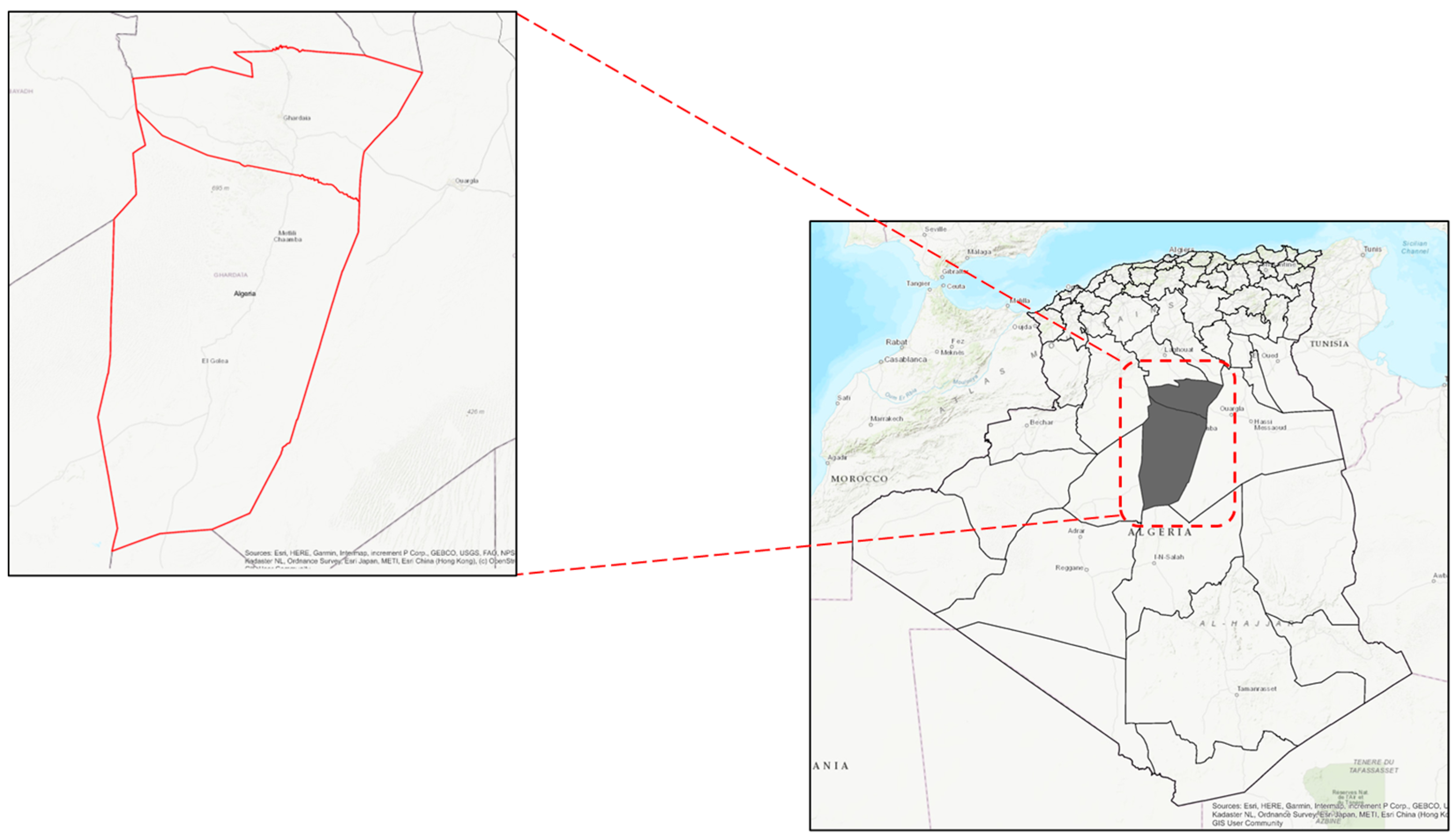
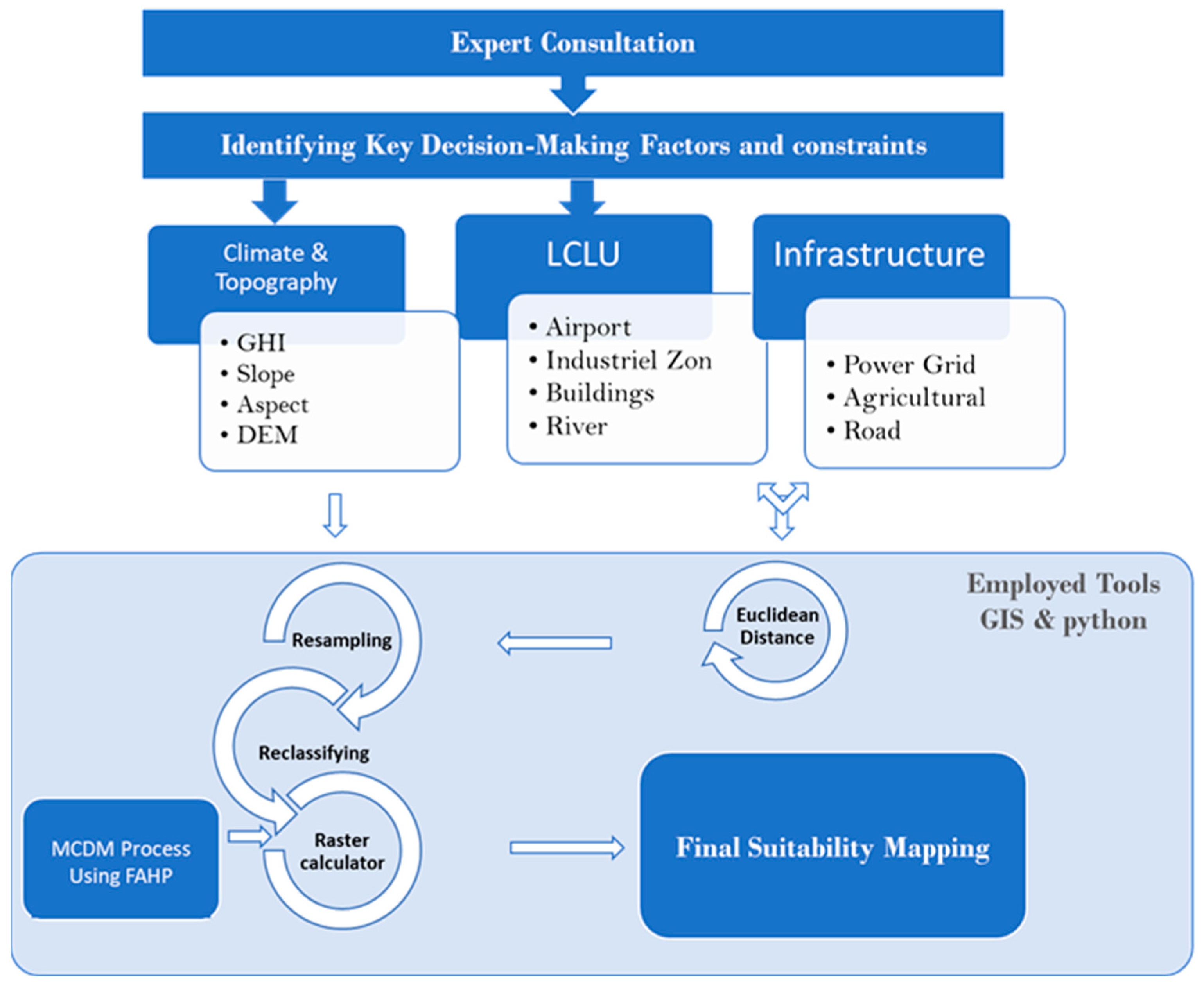
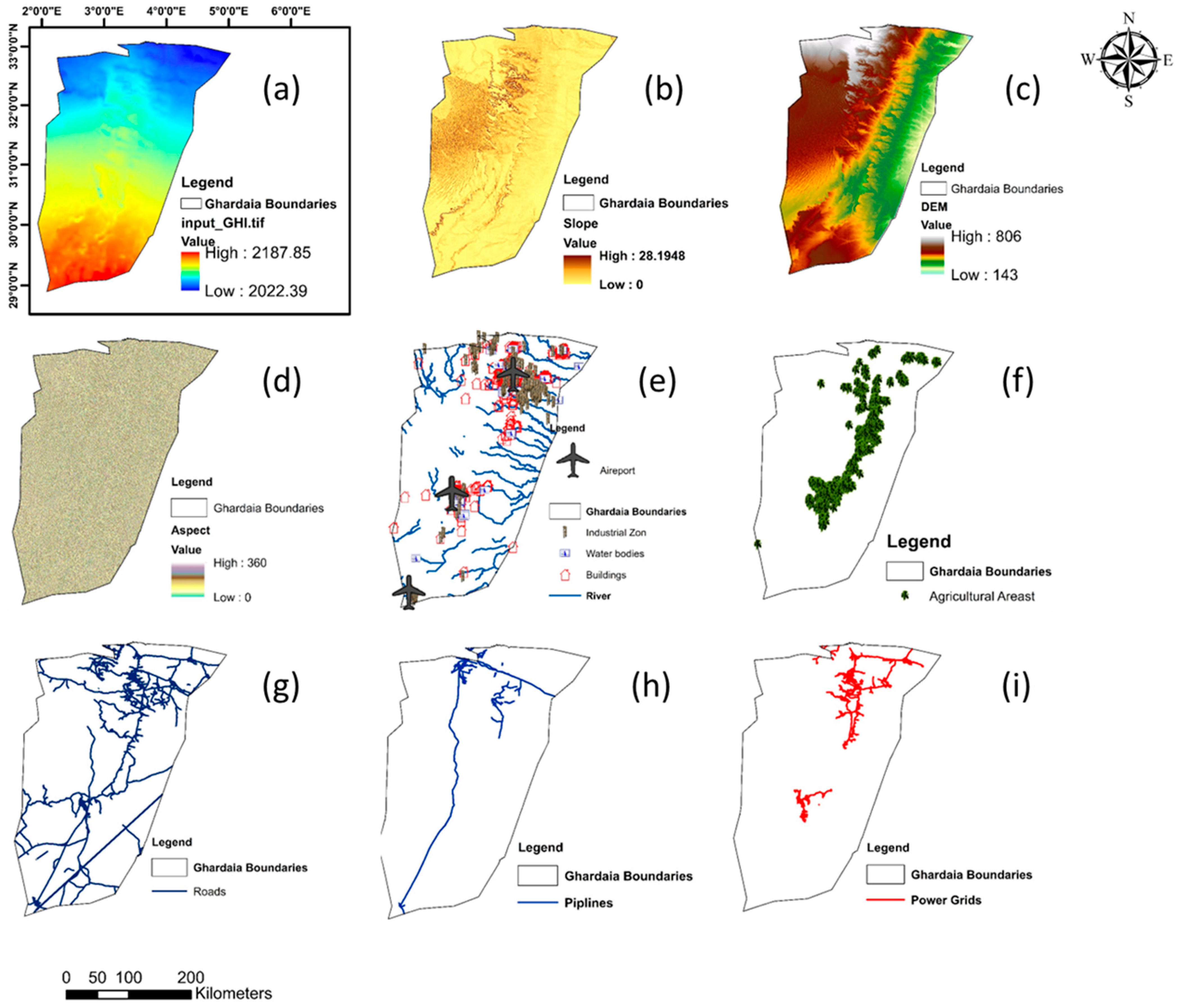

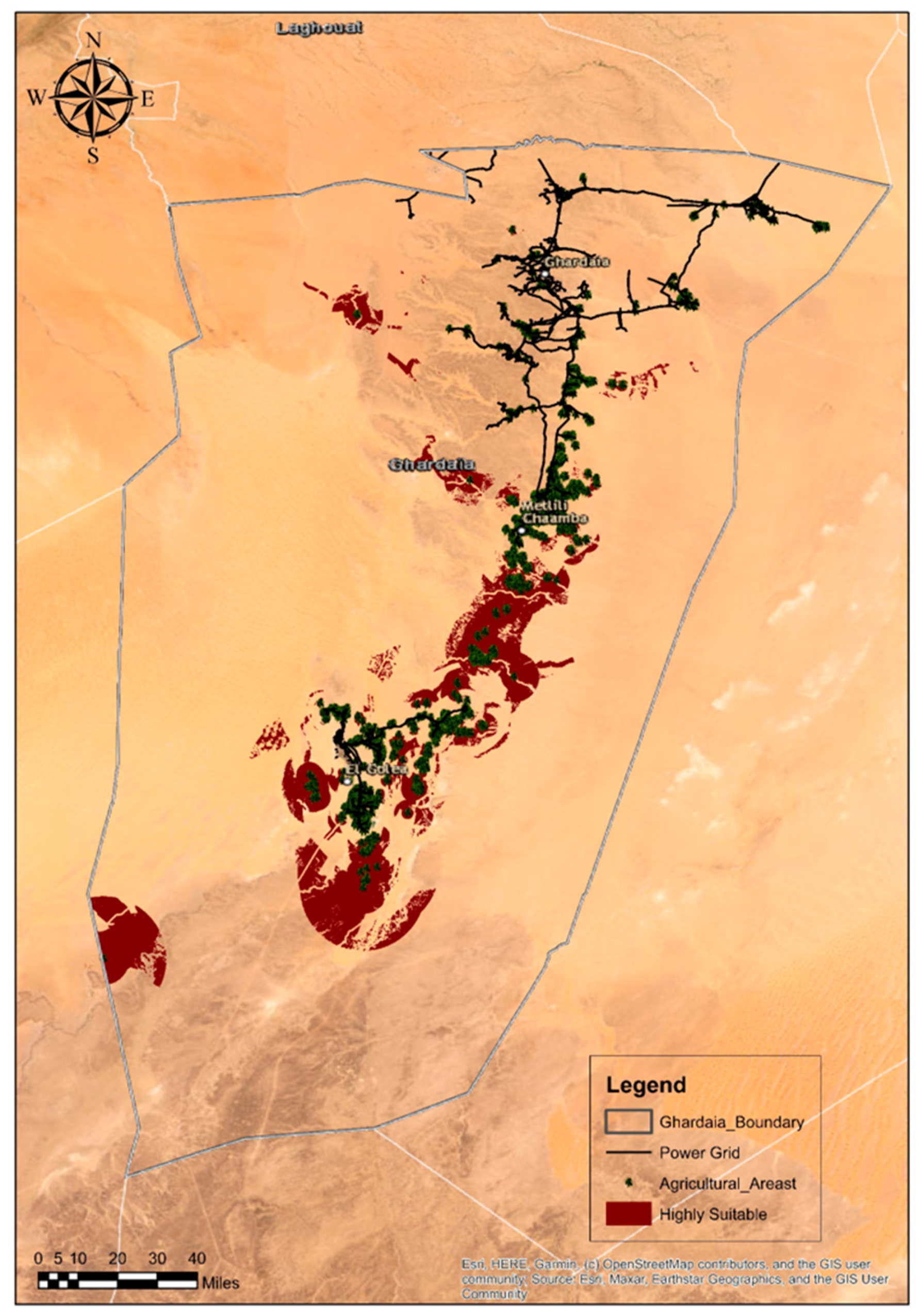
| TFN Scale | Definition |
|---|---|
| (1,1,1) | Indicates equal importance between the two criteria. |
| (1,2,3) | Suggests that the row criterion is Slightly More Important than the column criterion. |
| (3,4,5) | Reflects a Moderately More Important relationship. |
| (5,6,7) | Denotes a Strongly More Important relationship. |
| (7,8,9) | Represents a Very Strongly More Important relationship. |
| Criteria | Power Grid | Farmland | GHI | Road | Slope | Aspect |
|---|---|---|---|---|---|---|
| Power Grid | (1,1,1) | (1,2,3) | (3,4,5) | (3,4,5) | (5,6,7) | (7,8,9) |
| Farmland | (1/3,1/2,1) | (1,1,1) | (1,2,3) | (3, 4, 5) | (3,4,5) | (5,6,7) |
| GHI | (1/5,1/4,1/3) | (1/3,1/2,1) | (1,1,1) | (1,2,3) | (1,2,3) | (3,4,5) |
| Road | (1/5,1/3,1/4) | (1/5,1/4,1/3) | (1/3,1/2,1) | (1,1,1) | (1,2,3) | (3,4,5) |
| Slope | (1/7,1/6,1/5) | (1/5,1/4,1/3) | (1/3,1/2,1) | (1/3,1/2,1) | (1,1,1) | (1,2,3) |
| Aspect | (1/9,1/8,1/7) | (1/7,1/6,1/5) | (1/5,1/4,1/3) | (1/5,1/4,1/3) | (1/3,1/2,1) | (1,1,1) |
| Criterion | Power Grid | Farmland | GHI | Road | Slope | Aspect | Sum |
|---|---|---|---|---|---|---|---|
| Weight | 0.35 | 0.25 | 0.13 | 0.12 | 0.10 | 0.07 | 1.00 |
| Class | Suitability Class | Surface Area (ha) | 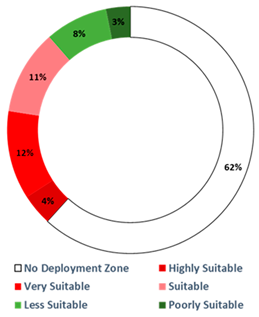 |
| 1 | No Deployment Zone | 5,212,734.10 | |
| 2 | Highly Suitable | 346,673.30 | |
| 3 | Very Suitable | 977,606.84 | |
| 4 | Suitable | 937,385.97 | |
| 5 | Less Suitable | 697,156.09 | |
| 6 | Poorly Suitable | 268,680.62 | |
| Total | 8,364,072.03 |
Disclaimer/Publisher’s Note: The statements, opinions and data contained in all publications are solely those of the individual author(s) and contributor(s) and not of MDPI and/or the editor(s). MDPI and/or the editor(s) disclaim responsibility for any injury to people or property resulting from any ideas, methods, instructions or products referred to in the content. |
© 2024 by the authors. Licensee MDPI, Basel, Switzerland. This article is an open access article distributed under the terms and conditions of the Creative Commons Attribution (CC BY) license (https://creativecommons.org/licenses/by/4.0/).
Share and Cite
Belaid, A.; Guermoui, M.; Khelifi, R.; Arrif, T.; Chekifi, T.; Rabehi, A.; El-Kenawy, E.-S.M.; Alhussan, A.A. Assessing Suitable Areas for PV Power Installation in Remote Agricultural Regions. Energies 2024, 17, 5792. https://doi.org/10.3390/en17225792
Belaid A, Guermoui M, Khelifi R, Arrif T, Chekifi T, Rabehi A, El-Kenawy E-SM, Alhussan AA. Assessing Suitable Areas for PV Power Installation in Remote Agricultural Regions. Energies. 2024; 17(22):5792. https://doi.org/10.3390/en17225792
Chicago/Turabian StyleBelaid, Abdelfetah, Mawloud Guermoui, Reski Khelifi, Toufik Arrif, Tawfiq Chekifi, Abdelaziz Rabehi, El-Sayed M. El-Kenawy, and Amel Ali Alhussan. 2024. "Assessing Suitable Areas for PV Power Installation in Remote Agricultural Regions" Energies 17, no. 22: 5792. https://doi.org/10.3390/en17225792
APA StyleBelaid, A., Guermoui, M., Khelifi, R., Arrif, T., Chekifi, T., Rabehi, A., El-Kenawy, E.-S. M., & Alhussan, A. A. (2024). Assessing Suitable Areas for PV Power Installation in Remote Agricultural Regions. Energies, 17(22), 5792. https://doi.org/10.3390/en17225792







